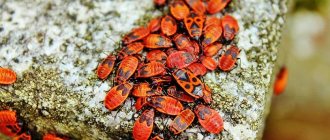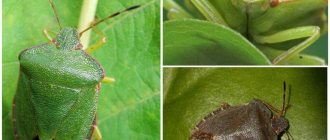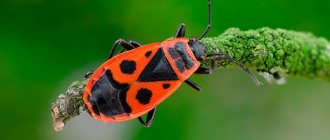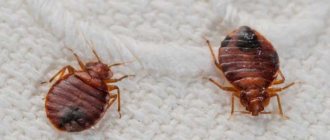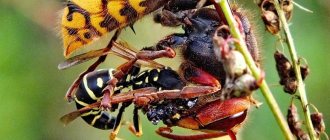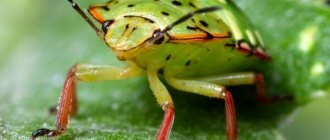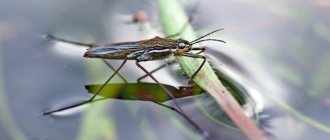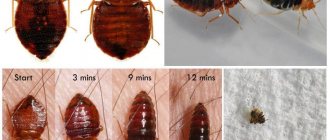Description of the species
The stink bug is a member of the Pentatomidae family. It belongs to the order Hemiptera. The characteristic “incense” is given to the insect for a reason: it is a signal to navigate the area, a way of communication and a defense mechanism. A smelly liquid is secreted from special glands located on the cephalothorax. The strongest odor is produced when a bug is crushed; however, the insect itself does not suffer from it.
Stinkers lead a measured lifestyle. In the warm season, most of the time is spent searching for food and a mating partner. At the first sign of frost, insects are puzzled by the options for a suitable place to hibernate. Usually this is a pile of leaves in which it is convenient to burrow. The lifespan of a stink bug is about two years.
Habitat
The stink bug lives almost everywhere:
- Asian countries;
- European countries;
- Africa;
- Australia;
- Russia;
- North and South America.
REFERENCE! Individual representatives can be found even in Alaska and Chukotka.
These insects prefer to live in temperate climates. Under natural conditions, stink bugs live in the garden, in a bird's nest, an animal's burrow or a hollow tree.
Appearance
There are many types of stink bugs known in nature:
- woody - considered the most common. It gives off the most persistent stinky odor. This insect has a light green color;
- turtle – distinguished by a convex brown shell;
- lined - has a red color with longitudinal black stripes;
- cruciferous - its variegated pattern consists of black and light areas;
- berry – the mustard color is framed by bright yellow stripes on the sides;
- red-legged - easily recognized by its bronze color;
Green, gray and turquoise stink bugs are also known.
Insects have 3 pairs of legs and antennae on their heads. The average size of adult individuals can reach 15-17 mm in length. Twice a year, in autumn and spring, stink bugs change color and become darker.
Look at the photo to see what a stink bug looks like.
The rounded shape of the body in each species is distinguished by small protrusions on the sides. The outer cover is chitinous and hard. It serves as a shield from attacks by other insects. Brown wings are located at the end of the back.
Juveniles are not much different from adults. The only sign is the absence of wings, which help the beetle to rise only slightly above the ground, but do not have a large span at all.
REFERENCE! During its life, the stinker manages to shed its shell 5 times; over time, it becomes cramped for it. This process stops when the insect stops growing.
How does it reproduce
The bug needs an unpleasant, smelly secretion to attract a partner for mating. In this way, the insect shows its readiness to reproduce. For successful mating, only two conditions will need to be met: air temperature in the region of plus 20-30 degrees and proximity to a food source.
Stink bugs reach maturity at the age of 1.5 months. The males penetrate the female's abdomen with their genitals and leave the seed there. The female can use it at her own discretion.
Typically, females lay stink bug eggs in small pieces, and the remains of the seed remain in their body for a long time. In total, a female bedbug can lay from 20 to 200 eggs. All of them have a special “lid” that opens at the right moment, and stink bug larvae appear from it.
What does it eat?
Stink bugs are mostly vegetarians. They prefer the juice of various plants as food. Because of this, great damage can be caused, resulting in devastated agricultural land.
The type of plant food depends on the species. Let's look at what stink bugs eat:
- lined - love carrots, parsley and dill;
- cruciferous stink bugs prefer radishes, turnips and cabbage;
- Berry, as the name suggests, eat all berries: gooseberries, raspberries, black and white currants.
- red-legged - drink the sap of fruit trees and feast on smaller parasites.
When young animals emerge from insect eggs, the rate of vegetation destruction increases sharply. The larvae prefer young shoots.
Benefits and harms
The main harm from the bug is the destruction of plants. The stink bug has a piercing-sucking type of mouthparts. He pierces the stems with a special rim and sucks out all the nutritious juices from them. The cause of the death of crops is the poison that the bug releases at the time of sucking.
The stink bug is capable of leaving marks on fruits and berries even if it does not spoil them. Fruits should not be eaten after this. Representatives of some species go unnoticed on plants: the green color allows them to skillfully camouflage themselves on the leaves. To calculate them, you need to know the intricacies of the body structure of bedbugs.
The beneficial properties of stink bugs are used to prepare a remedy for alcoholism. Insects are added to vodka and infused for 10 days. After taking the medicine, there is an aversion to all strong drinks. However, the method does not have precise scientific evidence.
In rare cases, stink bugs destroy the larvae of harmful animals, caterpillars and aphids. For example, the species of two-toothed bugs is considered exclusively predatory, so there is no need to exterminate it.
Harm of the stink bug
The stink bug causes indirect harm to humans. It does not pose a threat to health: feeding exclusively on plant sap, human blood does not attract the parasite. But the bug population can destroy the harvest in a short time.
The first parasites appear at the beginning of winter, when frosts begin to subside and the first shoots appear. The insect destroys the shoots of young plants very quickly. As a result, a person may be left without a harvest at all.
The stink bug pierces a shoot or leaf of a plant with its proboscis and sucks out fresh juice from it. After some time, the plants may die. On average, the female lays about 40 eggs at a time. If you do not eradicate parasites in time and do not take preventive measures, the population will grow to large sizes and it will be very difficult to destroy bedbugs.
Why are they dangerous?
Stink bugs rarely bite people and domestic animals, because the basis of their diet is plant foods. If you are bitten by a stink bug and marks become noticeable on your body, or signs of a severe allergic reaction appear, then you need to consult a doctor. The specialist will examine the damaged areas and prescribe the necessary treatment measures. Although insects do not carry infectious diseases, consulting a doctor will not be superfluous.
Killing and eating another insect is an exceptional case for a stink bug, so a bug bite is extremely rare. This only happens if no plant food is found. Bedbugs have external digestion, so they do not eat their prey right away - they first kill it and wait for decomposition.
How to get rid of stink bugs in a house or apartment
It is important for bedbugs to live in the most comfortable conditions possible. If the situation in the natural environment changes, they seek shelter in a person’s home. Stinkers can take a liking to pots of flower plants and begin to destroy green plantings. The easiest way to get rid of uninvited guests is to throw them out the window. It is not recommended to use a vacuum cleaner, as bedbugs will “take revenge” with a characteristic odor that will take a long time to get rid of.
If there is a stink bug at home, then it is important to use a folk recipe based on a soap solution and nicotine. Crush a pack of cheap cigarettes in two liters of water. Wait a little and mix with dishwashing detergent. Strain and use the resulting poison as a spray.
Hairspray will help seal the glands on the pest's body, from which the unpleasant odor emanates.
REFERENCE! The most effective means of prevention is a mosquito net. She will not allow any insect into the apartment.
The source of unpleasant odor in the house is not so much the bedbugs themselves as their nests. Traces of vital activity accumulate in the habitats of parasites. Until they are completely cleaned, there is no point in fighting the smell. After this, it is recommended to wipe the surfaces with vinegar or grape juice.
What are stink bugs?
It is difficult to notice the parasite on leaves or shoots: its oblong body, slightly flattened on the sides, and its characteristic light green color allow it to merge with the plant and remain invisible. The eggs of the parasite are also green and difficult to see with the naked eye.
Adults grow to 10-12 mm in length. The upper part of the body is covered with a hard shell, under which thin wings are hidden. A characteristic feature of the stink bug (which is why it got its name) are glands that secrete an unpleasant odor in case of danger.
Important! The stink bug feeds exclusively on the juice of young plants: wheat, tomatoes, cabbage and others. He is not attracted to the blood of humans or domestic animals.
In winter, the insect falls into a state of suspended animation - hibernation - and hides in old foliage, tree hollows, and fence cracks. If there is an abandoned barn or grain storage facility near your summer cottage, the bug will most likely move there.
The larvae resemble adults in appearance. The main difference is that the proboscis for receiving food is not fully developed. It is much thinner than that of adult bugs, so the larvae are found near young plants, the shoots of which are easier to pierce.
What to poison in the garden
If stink bugs attack your garden plot, you will have to use more radical measures, otherwise they will ruin almost the entire harvest and fruit and berry crops.
There are folk pest control measures, so let’s look at how to deal with the stink bug:
- Manual collection of insects, if the infestation area is not yet very large. But this technique is not highly effective. Gloves and closed clothing are required for work. Pests are dumped into a container with water - this helps get rid of the unpleasant odor.
- If you don’t know how to poison bedbugs, then use this recipe to treat plants. A glass of onion peel is soaked in a large bucket of hot water and left to infuse for 5 days. The spraying process should be carried out twice a day, once a week.
- Another affordable remedy for stink bugs. Take 100 g of dry mustard powder and dissolve it in 0.5 liters of boiling water. Stir thoroughly. Dilute the resulting mixture in a bucket of water.
- Spraying with chlorophos or phosphamide. When using chemicals, it is important to follow clear instructions and follow safety precautions. Adults successfully lay eggs on the leaves, so even this does not guarantee complete elimination of bedbugs.
- Plant plants that repel pests, such as black cohosh, throughout the area. The garden stink bug cannot stand its smell.
Prevention of insects
To prevent bedbugs from moving into the house (especially for private houses and summer cottages), it is recommended to install mosquito nets on the windows. Plant a plant called black cohosh along the perimeter of the summer cottage and around the house. It actively repels pests with its unpleasant odor and does not allow them to get too close to the house and crops.
Bed bugs tolerate winter quite well. Before the onset of the first frost, it is necessary to remove fallen leaves, weeds and snags, in which parasites can hide from the cold. Carefully check cracks and holes in the fence, hollows.
As a preventive measure, you can use folk remedies, since they do not cause harm to humans and plants. Once a month for 2-3 days, spray mustard solution or onion peel tincture.
Natural enemies
The main enemies of stink bugs are telenomines, which parasitize eggs. The phasia fly can also destroy the future legacy of the bug. She lays her offspring directly in their eggs, and the hatched larvae eat the remains of organic tissue. Hedgehogs eat both embryos and adult bedbugs. Toads and frogs are not averse to eating stinkers.
Birds, both forest and domestic, can be added to the ranks of ill-wishers who will help eliminate the stink bug. Chickens, for example, are often let out to walk around the garden, and they do not miss the opportunity to taste the bugs. Less commonly, insects become victims of small rodents and dogs.
The stink bug can be called a controversial insect. On the one hand, it helps a person in the fight against pests, on the other hand, stink bugs can cause enormous harm. In most cases, it does not pose a danger to people. Therefore, you need to act prudently and start fighting bedbugs only if there is a real threat.
Types of bedbugs and danger to humans
Stink bugs have long been popularly called representatives of stink bugs, which are characterized by a wide variety of species. In central Russia, the most common species of this insect are:
- gray shieldweed;
- berry shield;
- green shield bug;
- lined stink bug;
- Elasmostetus birch;
- deciduous woody kelevik.
It is these small insects that most often become uninvited guests in our houses and apartments. All of the above types of stink bugs have one characteristic: they pose absolutely no danger to humans and feed only on the juice of fruits and plants.
Even representatives of the genera Nabis and Orius, which eat other insects and are considered predators, do not bite or attack humans. Only the American stink bug can be dangerous, but these insects do not live in Russia.

